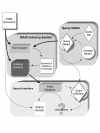Methods for semi-automated indexing for high precision information retrieval
- PMID: 12386114
- PMCID: PMC349380
- DOI: 10.1197/jamia.m1075
Methods for semi-automated indexing for high precision information retrieval
Abstract
Objective: To evaluate a new system, ISAID (Internet-based Semi-automated Indexing of Documents), and to generate textbook indexes that are more detailed and more useful to readers.
Design: Pilot evaluation: simple, nonrandomized trial comparing ISAID with manual indexing methods. Methods evaluation: randomized, cross-over trial comparing three versions of ISAID and usability survey.
Participants: Pilot evaluation: two physicians. Methods evaluation: twelve physicians, each of whom used three different versions of the system for a total of 36 indexing sessions.
Measurements: Total index term tuples generated per document per minute (TPM), with and without adjustment for concordance with other subjects; inter-indexer consistency; ratings of the usability of the ISAID indexing system.
Results: Compared with manual methods, ISAID decreased indexing times greatly. Using three versions of ISAID, inter-indexer consistency ranged from 15% to 65% with a mean of 41%, 31%, and 40% for each of three documents. Subjects using the full version of ISAID were faster (average TPM: 5.6) and had higher rates of concordant index generation. There were substantial learning effects, despite our use of a training/run-in phase. Subjects using the full version of ISAID were much faster by the third indexing session (average TPM: 9.1). There was a statistically significant increase in three-subject concordant indexing rate using the full version of ISAID during the second indexing session (p < 0.05).
Summary: Users of the ISAID indexing system create complex, precise, and accurate indexing for full-text documents much faster than users of manual methods. Furthermore, the natural language processing methods that ISAID uses to suggest indexes contributes substantially to increased indexing speed and accuracy.
Figures






Similar articles
-
Selective dissemination and indexing of scientific information.Science. 1971 Jul 23;173(3994):300-8. doi: 10.1126/science.173.3994.300. Science. 1971. PMID: 5559903
-
Contextual models of clinical publications for enhancing retrieval from full-text databases.Proc Annu Symp Comput Appl Med Care. 1995:851-7. Proc Annu Symp Comput Appl Med Care. 1995. PMID: 8563412 Free PMC article.
-
The NLM Indexing Initiative's Medical Text Indexer.Stud Health Technol Inform. 2004;107(Pt 1):268-72. Stud Health Technol Inform. 2004. PMID: 15360816
-
Information retrieval at the millenium.Proc AMIA Symp. 1998:38-45. Proc AMIA Symp. 1998. PMID: 9929180 Free PMC article. Review.
-
Hairpins in bookstacks: information retrieval from biomedical text.Brief Bioinform. 2005 Sep;6(3):222-38. doi: 10.1093/bib/6.3.222. Brief Bioinform. 2005. PMID: 16212771 Review.
Cited by
-
EliXR: an approach to eligibility criteria extraction and representation.J Am Med Inform Assoc. 2011 Dec;18 Suppl 1(Suppl 1):i116-24. doi: 10.1136/amiajnl-2011-000321. Epub 2011 Jul 31. J Am Med Inform Assoc. 2011. PMID: 21807647 Free PMC article.
-
Constructing a concise medical taxonomy.J Med Libr Assoc. 2005 Jan;93(1):121-3. J Med Libr Assoc. 2005. PMID: 15685285 Free PMC article. No abstract available.
-
Improving precision in concept normalization.Pac Symp Biocomput. 2018;23:566-577. Pac Symp Biocomput. 2018. PMID: 29218915 Free PMC article.
-
A pilot study of contextual UMLS indexing to improve the precision of concept-based representation in XML-structured clinical radiology reports.J Am Med Inform Assoc. 2003 Nov-Dec;10(6):580-7. doi: 10.1197/jamia.M1369. Epub 2003 Aug 4. J Am Med Inform Assoc. 2003. PMID: 12925544 Free PMC article.
-
Modeling the relationship between search terms in clinical queries.AMIA Annu Symp Proc. 2005;2005:1167. AMIA Annu Symp Proc. 2005. PMID: 16779453 Free PMC article.
References
-
- Forsythe DE, Buchanan BG, Osheroff JA, Miller RA. Expanding the concept of medical information: An observational study of physicians’ information needs. Comput Biomed Res. 1992;25(2):181–200. - PubMed
-
- Covell DG, Uman GC, Manning PR. Information needs in office practice: are they being met? Ann Intern Med. 1985; 103:596–9. - PubMed
-
- Chambliss ML, Conley J. Answering clinical questions. J Fam Pract. 1996;43(2):140–4. - PubMed
-
- Hersh WR, Hickam DH. An evaluation of interactive Boolean and natural language searching with an online medical textbook. J Am Soc Info Sci. 1995;46(7):478–9.
Publication types
MeSH terms
LinkOut - more resources
Full Text Sources
Other Literature Sources

